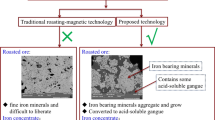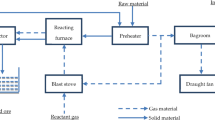Abstract
The features of the techniques of fast reducing roasting (FRR) and conventional magnetic roasting, as well as tremendous demands of iron ores in iron and steel industry of China, were briefly described. The test equipment suitable for FRR of fine-grained materials was introduced. Weakly magnetic materials with grain size of <0.30 mm were converted into strongly magnetic materials by FRR for several to dozens of seconds. In a weakly reducing atmosphere and at 740–800 °C, refractory powder iron material (<0.30 mm) which is rich in specularite, limonite and Mg-Mn siderite was subjected to FRR for a few seconds to 60 s. Concentrate with iron grade of 55.67%–55.21%, high contents of Mg and Mn in the ore is obtained and the yield of magnetic separation reaches 81.66%–86.57%. The results of X-ray diffraction (XRD) analysis and magnetism detection of the material before and after FRR indicate that weakly magnetic material is mainly converted into strongly magnetic material Fe3O4 with specific saturation magnetic moment. The efficiency of FRR is consistent with TFe recovery of magnetic separation; meantime, the specific saturation magnetic moment increases from 33 to 42 times after FRR. Calculations show that speeds of flash magnetic roasting are obtained from several dozen to two or three hundred times, compared with rotary kiln or shaft furnace. This indicates that it is practicable to use the fast reducing roasting technique to improve the comprehensive utilization of iron ore resources.
Similar content being viewed by others
References
LUO Li-qun, ZHANG Jing-sheng. Analysis of the ironmaking raw materials market in China [J]. Journal of Wuhan University of Technology, 2005, 27(9): 67–69. (in Chinese)
CHENK J L. Recent status of fluidized bed technologies for producing iron input materials for steelmaking [J]. Particuology, 2011, 9(1): 14–21.
LUO Li-qun, ZHANG Jing-sheng. Film-magnetic separation technique to strengthen the separation of complicated weak-magnetic minerals [C]// International Conference of Iron Ore 2005. Fremantle, Australia, 2005: 371–378.
YU Yong-fu. Development trends of iron mines and status and problems of beneficiation technology in China [J]. Mining and Metallurgical Engineering, 2006, 26(1): 21–25. (in Chinese)
CUI Z, LIU Q, ETSELL T H. Magnetic properties of ilmenite, hematite and oilsand minerals [J]. Minerals Engineering, 2002, 15(12): 1121–1129.
ZHANG Jing-sheng, LUO Li-qun. Actuality of magnetic separation technique [J]. Mining and Metallurgical Engineering, 2005, 25(3): 25–29. (in Chinese)
LUO Li-qun, ZHANG Jing-sheng, GAO Yuan-yang. Research on dry cooling magnetic roasting technology for siderite ore [J]. Metal Mine, 2004, (10): 28–31, 35. (in Chinese)
ÇIÇEK B, BILGESÜ, ŞENELTA A M, PAMUK V. Desulphurization of coals by flash pyrolysis followed by magnetic separation [J]. Fuel Processing Technology, 1996, 46(2): 133–142.
SRINIVASAM N S, STAFFANSSON L I. A theoretical analysis of the fluidized-bed process for the reduction of iron ores [J]. Chemical Engineering Science, 1990, 45(15): 1253–1265.
SRINIVASAM N S. Reduction of iron oxides by carbon in a circulating fluidized bed reactor [J]. Powder Technology, 2002, 124(1/2): 28–39.
CAVANAGH P E. Autogenous roasting of iron ore [P]. US Patent 5244 494, 1993.
YOUSSEF M A, MORSI M B. Reduction roast and magnetic separation of oxidized iron ores for production of blast furnace feed [J]. Canada Metallurgical Quarterly, 1998, 37(5): 419–428.
LUO Li-qun, ZHANG Jing-sheng, YU Yong-fu. New technology and magnetic property of fast reducing roasting for fine iron bearing materials [C]// The 5th International Congress on the Science and Technology of Ironmaking (2009). Shanghai, China, 2009: 488–493.
LIU Q F. Study on pro-concentration technique to Jingtieshan ore in Jiuquan iron and steel (group) Co. Ltd [D]. Xi’an: College of Metallurgical Engineering, Xi’an University of Architecture and Technology, 2003. (in Chinese)
LUO Li-qun, ZHANG Jing-sheng, YU Yong-fu. Flash magnetic roasting and microstructure characteristics & phase transformation of iron minerals [J]. Journal of Central South University: Science and Technology, 2009, 40(5): 1172–1177. (in Chinese)
SUR S K. Measurement of magnetic susceptibility and magnetic moment of paramagnetic molecules in solution by high-field Fourier transform NMR spectroscopy [J]. Journal of Magnetic Resonance, 1989, 82(1): 169–173.
BERTINI I, LUCHINAT C, PARRIGI G. Magnetic susceptibility in paramagnetic NMR [J]. Progress in Nuclear Magnetic Resonance Spectroscopy, 2002, 40(3): 249–273.
Author information
Authors and Affiliations
Corresponding author
Additional information
Foundation item: Project(20070497048) supported by China Scholarship Council, Ministry of Education of China
Rights and permissions
About this article
Cite this article
Luo, Lq., Huang, H. & Yu, Yf. Characterization and technology of fast reducing roasting for fine iron materials. J. Cent. South Univ. 19, 2272–2278 (2012). https://doi.org/10.1007/s11771-012-1271-3
Received:
Accepted:
Published:
Issue Date:
DOI: https://doi.org/10.1007/s11771-012-1271-3




